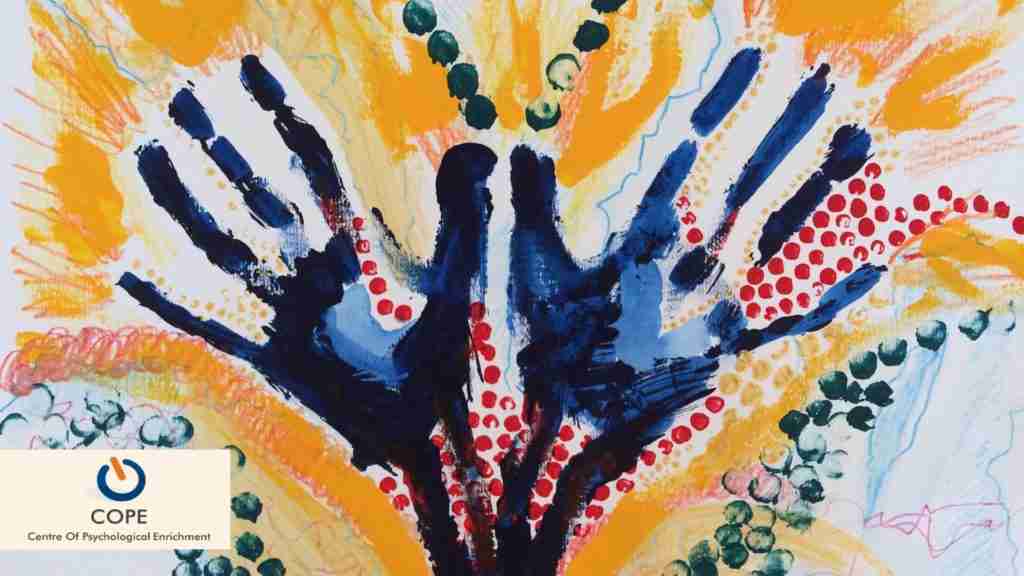The origins of Art as embodied way of healthy living
The healing qualities of artmaking go back to the early history of mankind. In the past, it was an integral part of life. Art was used to process and document emotional experiences linked to life events, rituals, values and beliefs.
However, that changed in modern life. Art became a field of exploration separated from daily life. Something important was lost on the way of acknowledging artmaking as a special gift for creative expression. It took away people’s freedom to allow creativity to be part of life, a way to communicate individual as well as collective needs and desires.
Art and the creative process became somewhat exclusive and untouchable. While artists would create, others would consume and contemplate but without the privilege to create themselves. They would reflect on someone else‘s perception of the world from a distant view through intellectual observation. The approach of using art for healing as embodied process was left behind.
The Philosophy of Arts Therapy around Imagination & Creativity
Over the past thirty years, researchers, artists and therapists began to position Arts Therapy in the field of Health Research. The aim was to go back to the origins of artmaking to validate art as a healing method. More awareness was raised to realise the importance of creativity & imagination for healing the mind, body and soul. Using creative arts therapy as a form of psychodynamic psychotherapy, we allow creativity and imagination back into our lives. Art helps us to explore trauma, and cultural and spiritual aspects while focusing on self-development and healthy self-growth.
Neuroscience and Arts Therapy
Thanks to more research done in the area of neuroscience linked to art, we are now able to demonstrate the many methods used in arts therapy to help rewire the brain, i.e. in relation to emotion regulation. Artistic processes can be extremely beneficial for our physical and psychological well-being. You will find this further explored in future blog posts.
Client Therapist Relationship: make space for developing trust in the creative process
The arts therapist creates a connection with clients through various media and modalities and the use of metaphor. We draw, paint, write, use movement and other techniques to explore evolving imagery through psychoanalytical approaches.
As an Arts Therapist, I engage in my own therapeutic journey and continuous self-reflection. This helps me to register and understand transference and countertransference between client and therapist.
In today’s fast-paced world, it is extremely important to have access to a space that allows us to pause and check in with our self, our body, our soul. A space that allows us to explore past and recent experiences. Often, these are linked to inner wounds and scars that may have been buried deep down in our psyche for a long time. However, our body remembers, and arts therapy encourages clients to gain insight. We gain new perspectives by communicating in verbal and non-verbal ways through multimodal and embodied processes.
Outlook
I strongly believe in the healing qualities of art. We can build links between internalised processes and the external world. Also, we gain insight into our functional and dysfunctional behaviour patterns, thought cycles and emotional states. We learn to listen to our bodies and grow more awareness concerning our needs and wants.
Working with creative modalities is a rich form of action-based therapy. Thankfully, it is a growing field, recognised for its powerful qualities to improve our overall health. While we create, we form relationships, make connections and grow a positive self-image that strengthens us to explore our whole being in this world.
It needs time to nurture a self that had missed out as a child, that didn’t play and had to worry, felt guilty and shamed, with a lack of love. In Arts Therapy you are heard, understood, held and supported on your journey to self-repair, healing and self-activation.
At COPE you make the changes that you need to be able to move forward by reconnecting to your inner child at your own pace in the creative environment of Arts Therapy.
By Elisabeth Eitelberger, AThR COPE
References
Dissanayake, E. (1995). Homo aestheticus: Where art comes from and why (1st University of Washington Press ed.). University of Washington Press.
Eberhart, H., & Atkins, S. S. (2014). Presence and process in expressive arts work: At the edge of wonder. Jessica Kingsley Publishers.
Hass-Cohen, N., & Findlay, J. C. (2015). Art therapy & the neuroscience of relationships, creativity, & resiliency: Skills and practices. W.W. Norton & Company.
Kaplan, F. (2000). Art, science, and art therapy: Repainting the picture. Jessica Kingsley Publishers.
King, J. L. (2016). In King J. L. (Ed.), Art therapy, trauma, and neuroscience: Theoretical and practical perspectives. Routledge. https://doi.org/10.4324/9781315733494
Knill, P. J., Levine, S. K., & Levine, E. G. (2005). Principles and practice of expressive arts therapy: Towards a therapeutic aesthetics. Jessica Kingsley Publishers.
Levine, E. G., editor, & Levine, S. K., editor. (2017). New developments in expressive arts in therapy: The play of poiesis. Jessica Kingsley Publishers.
Halprin, D. (2003;2002;). The expressive body in life, art, and therapy: Working with movement, metaphor, and meaning. Jessica Kingsley Publishers.
Levine, S. K., author. (2019). Philosophy of expressive arts therapy: Poiesis and the therapeutic imagination. Jessica Kingsley Publishers.
Malchiodi, C. A. (2005). Expressive therapies. Guilford Press.
McNiff, S. (2004). Art heals: How creativity cures the soul. Shambhala.
Van der Kolk, Bessel A. (2015). The body keeps the score: Brain, mind, and body in the healing of trauma. Penguin Books.
